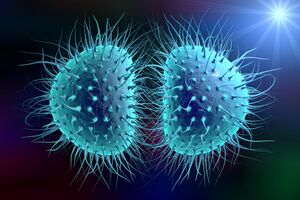Cognitive and Physical Effects of Bacterial Meningitis
Introduction

By Alyssa Gest
Meningitis, characterized by the inflammation of the meninges surrounding the brain and spinal cord, poses a significant threat to human health, especially acute bacterial meningitis [1]. Understanding the etiology and virulence factors of bacterial meningitis is crucial for prevention, diagnosis, and treatment. Such pathogens include Streptococcus pneumonia, Neisseria meningitidis, Haemophilus influenza, and Listeria monocytogenes [2] They demonstrate various mechanisms to break through the blood-brain barrier and invade the central nervous system[3] . These lead to altercations in the brain and spinal cord and later the infected person can develop cognitive impairment and physical consequences. These mechanisms enable bacterial colonization inside the hose cell and promote their survival. They also involve complex interactions with the virulence factors of the pathogenesis bacteria and the host cell immune mechanisms.[3] These processes help scientists and doctors develop targeted therapies and vaccines for bacterial meningitis.
Overview of Meningitis
Who's at Risk
Everyone is susceptible to catching bacteria meningitis. However, there are multiple pathogens that infect certain age groups more than others. Infants are most likely infected by Group B streptococcus (ex. Streptococcus agalactiae), gram-negative enteric organisms (ex. E.coli), and Listeria monocytogenes (L. monocytogenes)[4]. 1 to 23 month olds are susepctiable to Streptococcus pneumonia (S. pneumonia), Neisseria meningitidis (N. meningitides), S. agalactiae, Haemophilus influenzae (H. influenza), and E.coli[4]. Children and teens are most likely infected with N. meningitidis and S. pneumoniae (youtube). Those who are adults and elderly will most likely contract S. pneumoniae, and L. monocytogenes [5]. If you are over 50 years of age, N. meningitidis is also likely as well [4].
Short-term Complications
Brain Structure and Bacterial Invasion
Pathogentic Strains
Include some current research, with at least one figure showing data.
Cognitive and Physical Conseqences
Conclusion
References
- ↑ Zainel, Abdulwahed, Hana Mitchell, and Manish Sadarangani. 2021. "Bacterial Meningitis in Children: Neurological Complications, Associated Risk Factors, and Prevention" Microorganisms 9, no. 3: 535. https://doi.org/10.3390/microorganisms9030535
- ↑ Mehlhorn, Allana, and Brandon Sucher. Chrome-Extension://EFAIDNBMNNNIBPCAJPCGLCLEFINDMKAJ/https://www.nejm.org/doi/pdf/10.1056/nejmoa1905795?articletools=true, April 1, 2007. https://hdl.handle.net/10520/AJA16836707_629.
- ↑ 3.0 3.1 Herold, Rosanna, Horst Schroten, and Christian Schwerk. 2019. "Virulence Factors of Meningitis-Causing Bacteria: Enabling Brain Entry across the Blood–Brain Barrier" International Journal of Molecular Sciences 20, no. 21: 5393. https://doi.org/10.3390/ijms20215393
- ↑ 4.0 4.1 4.2 Mehlhorn, Allana, and Brandon Sucher. Chrome-Extension://EFAIDNBMNNNIBPCAJPCGLCLEFINDMKAJ/https://www.nejm.org/doi/pdf/10.1056/nejmoa1905795?articletools=true, April 1, 2007. https://hdl.handle.net/10520/AJA16836707_629.
- ↑ YouTube. (2017, November 8). Meningitis - causes, symptoms, diagnosis, treatment, pathology. YouTube. https://www.youtube.com/watch?v=gIHUJs2eTHA
Authored for BIOL 238 Microbiology, taught by Joan Slonczewski,at Kenyon College,2024
